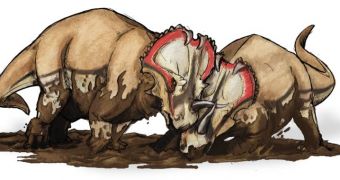Archaeologists and other researchers from China and the US are currently working together to uncover a mass grave, dating back more than 90 million years ago, which contains the remains of a large dinosaur group that got trapped in mud on the banks of a freshwater lake in the Gobi desert, Inner Mongolia. Nearly all of the animals found are youngsters of a single species, a discovery that sheds new light on the behavior exhibited by the ornithomimid dinosaur Sinornithomimus dongi.
According to preliminary estimates, the youth of a larger herd of S. dongi was wandering through the area that is now Western Inner Mongolia, when they came upon the freshwater lake that has long since dried up. On their approach to quench their thirst, the large group of animals got trapped in the muddy banks and simply died there, most likely of hunger and thirst. The fact that they were alone seems to confirm a largely-ignored scientific hypothesis, which holds that adult ornithomimid dinosaurs pushed their cubs away and ignored them, especially during nesting and brooding.
“There were no adults or hatchings,” University of Chicago professor Paul Sereno, who is also a National Geographic Explorer-in-Residence, explains. Inner Mongolia Department of Land and Resources expert Tan Lin adds that, “These youngsters were roaming around on their own.” The details of the scientific exploration and partnership are published in the December 2008 issue of the scientific journal Acta Palaeontologica Polonica.
“These animals died a slow death in a mud trap, their flailing only serving to attract a nearby scavenger or predator. I was saddened because I knew how the animals had perished. It was a strange sensation and the only time I had felt that way at a dig,” Sereno shares. He says that the mud around most of the remains exhibits scratch marks, left behind by the young dinosaurs, as they were trying to free themselves from the clay.
Two of the exemplars, which have already been airlifted to China and will soon go on display, were so well preserved, that experts have managed to identify stones in their bellies, which were usually used by herbivorous dinosaurs to digest their food. The animals' last meal also remained intact, so scientists hope that analyzing it will offer a new insight into how these creatures lived.

 14 DAY TRIAL //
14 DAY TRIAL //